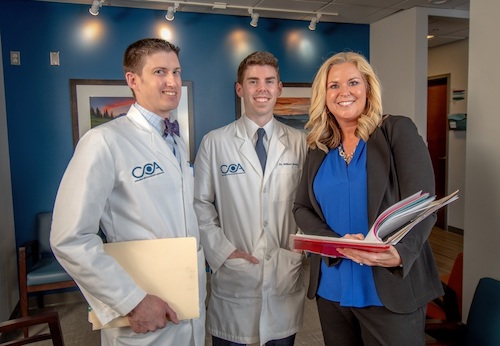Be aware of glaucoma symptoms
Learn the risks. Be proactive.
According to the American Academy of Ophthalmology (AAO), only half of people with glaucoma are aware they have the conditions. But what are the symptoms of glaucoma and how do they affect you? Read below to learn more.
Open-Angle Glaucoma Signs and Symptoms
Open-angle glaucoma is the most common form of the disease. This condition can develop gradually and be undetected for years, slowly damaging vision. Here are the signs and glaucoma symptoms:
- No early symptoms
- Gradual loss of peripheral vision, usually in both eyes
- Tunnel vision in the advanced stages

Closed-Angle Glaucoma Signs and Symptoms
Closed-angle glaucoma (also called narrow angle glaucoma) can be very rapid in onset and patients generally have symptoms that occur quite suddenly. It is related to the anatomical changes of the eye and can be picked up during a routine eye exam before any damage has occurred.
Simple, outpatient laser treatment is effective in curing this form of the disease. Here are the signs and symptoms:
- Severe eye pain
- Nausea and vomiting (accompanying the severe eye pain)
- Sudden onset of visual disturbance, often in low light
- Blurred vision
- Halos around lights
- Reddening of the eye
Glaucoma treatment options
Glaucoma is often called the “sneak thief of sight” because in many cases, there are no symptoms. Fortunately, glaucoma is highly treatable. The key to preventing serious vision loss or blindness from glaucoma is early detection.

An annual, fully dilated eye examination at Columbus Ophthalmology Associates is the best and earliest means to detect glaucoma.
Glaucoma treatment at Columbus Ophthalmology Associates involves medications, laser procedures and/or surgery to lower internal eye pressure by opening drainage passageways for the trapped fluid.
In early stages of glaucoma, laser or medications are used. If the condition worsens, surgical procedures are performed. Below are the surgical options for both types of glaucoma.
Surgical Treatment for Closed-Angle Glaucoma
Laser Peripheral Iridotomy
The only available laser surgical treatment for closed-angle glaucoma, this procedure uses a very focused beam of light to create a hole on the outer edge of the iris, where fluid is blocked. This opening allows the iris to fall back from the fluid channel, allowing the fluid to flow naturally and decreasing dangerous levels of pressure inside the eye.
Laser Treatment for Closed-Angle Glaucoma
Selective Laser Trabeculoplasty (SLT)
After eye drops are used to numb the eye, a laser is applied to the drainage tissue, starting a biological change in the tissue that results in better drainage of fluid.
This procedure takes about 5 -10 minutes, there are no patches required and there are no restrictions in post-laser activities.
Most patients can drive themselves to the procedure and are able to carry on normal activities immediately afterwards. This advanced laser treatment does not have the associated damage to other tissues or adverse scarring effects that the first generation Argon laser did. For this reason, SLT can be repeated multiple times to relieve eye pressure if necessary.
Surgical Treatment for Open-Angle Glaucoma
Filtering Microsurgery: Trabeculectomy
A standard surgical procedure for open-angle glaucoma, a tiny drainage channel is made in the sclera (the white part of the eye) in a procedure called trabeculectomy. The new drainage channel allows fluid to flow out of the eye and helps lower eye pressure, preventing or reducing damage to the optic nerve.
After eye drops are used to numb the eye, a laser is applied to the drainage tissue, starting a biological change in the tissue that results in better drainage of fluid. This procedure takes about 5 -10 minutes, there are no patches required and there are no restrictions in post-laser activities.
Most patients can drive themselves to the procedure and are able to carry on normal activities immediately afterward. This advanced laser treatment does not have the associated damage to other tissues or adverse scarring effects that the first generation Argon laser did. For this reason, SLT can be repeated multiple times to relieve eye pressure if necessary.

Canaloplasty
This procedure uses breakthrough microcatheter technology to enlarge your eye’s natural drainage system, similar to angioplasty. Dr. Derick was one of the first doctors in the country to perform this groundbreaking glaucoma treatment procedure. A small incision is made in the eye and then a canaloplasty microcatheter is inserted into the eye’s drainage system canal. Using the microcatheter, Dr. Derick will circle the canal and enlarge it, helping fluid to drain properly. The microcatheter is removed and a suture is placed within the canal to keep it open, restoring your eye’s natural drainage system and lowering your eye’s pressure.
iStent
The smallest medical device ever approved by the FDA, an iStent is placed in a patient’s eye during cataract surgery and is so small that a patient cannot see or feel it after the procedure is over. Dr. Derick was one of the first ophthalmologists in the stateto perform this cutting-edge procedure and remains an early adopter. The iStent was designed to create a permanent opening in the trabecular meshwork of the eye and works to improve the outflow of fluid, helping to control eye pressure. If you have both cataracts and glaucoma, the iStent procedure may be right for you.
Ex-Press Shunt
Smaller than a grain of rice, this filtration device relieves high eye pressure in patients with open-angle glaucoma when drops and other surgical treatments have been unsuccessful. Placed between the inner and outer layers of the eye, the Ex-Press Shunt bypasses the eye’s damaged drainage system, allowing excess fluid to drain and reducing eye pressure.
Dr. Robert Derick has been an innovator and leading instigator for a number of innovative glaucoma procedures. Fellowship-trained at The John Hopkins Wilmer Eye Institute, he was one of the first surgeons in the country and the state of Ohio to perform many of these cutting-edge procedures and continues to be a leader in this field.
A member of the American Glaucoma Society for over two decades and a board member of the Glaucoma Research Foundation, Dr. Derick has performed tens of thousands of glaucoma surgeries during his tenure at COA. You can learn about glaucoma by visiting the Glaucoma Research Foundation website.
Dr. Derick & Glaucoma
Dr. Robert Derick has been an innovator and leading instigator for a number of innovative glaucoma procedures. Fellowship-trained at The John Hopkins Wilmer Eye Institute, he was one of the first surgeons in the country and the state of Ohio to perform many of these cutting-edge procedures and continues to be a leader in this field. A member of the American Glaucoma Society for over two decades and a board member of the Glaucoma Research Foundation, he has performed tens of thousands of glaucoma surgeries during his tenure at COA. You can learn about glaucoma by visiting the Glaucoma Research Foundation website.
Real Patient Reviews
4.9 Star Average on Google & Facebook
Dr. McHale and his staff are awesome. I couldn’t ask for a more down to earth Doctor. His staff is the nicest staff I have ever seen. 10 stars out of 5.
My recent experience with Columbus Ophthalmology Associates was extremely professional. From my first appointment with Dr. McHale to the post-op nurse after my cataract surgery everyone was kind, friendly and very informative. Everyone made sure all my questions were answered and that I was comfortable. They especially took their time to alleviate any fear I may have been feeling. I am so thankful to have found Dr. McHale. I trust him with the care of my eyes.
